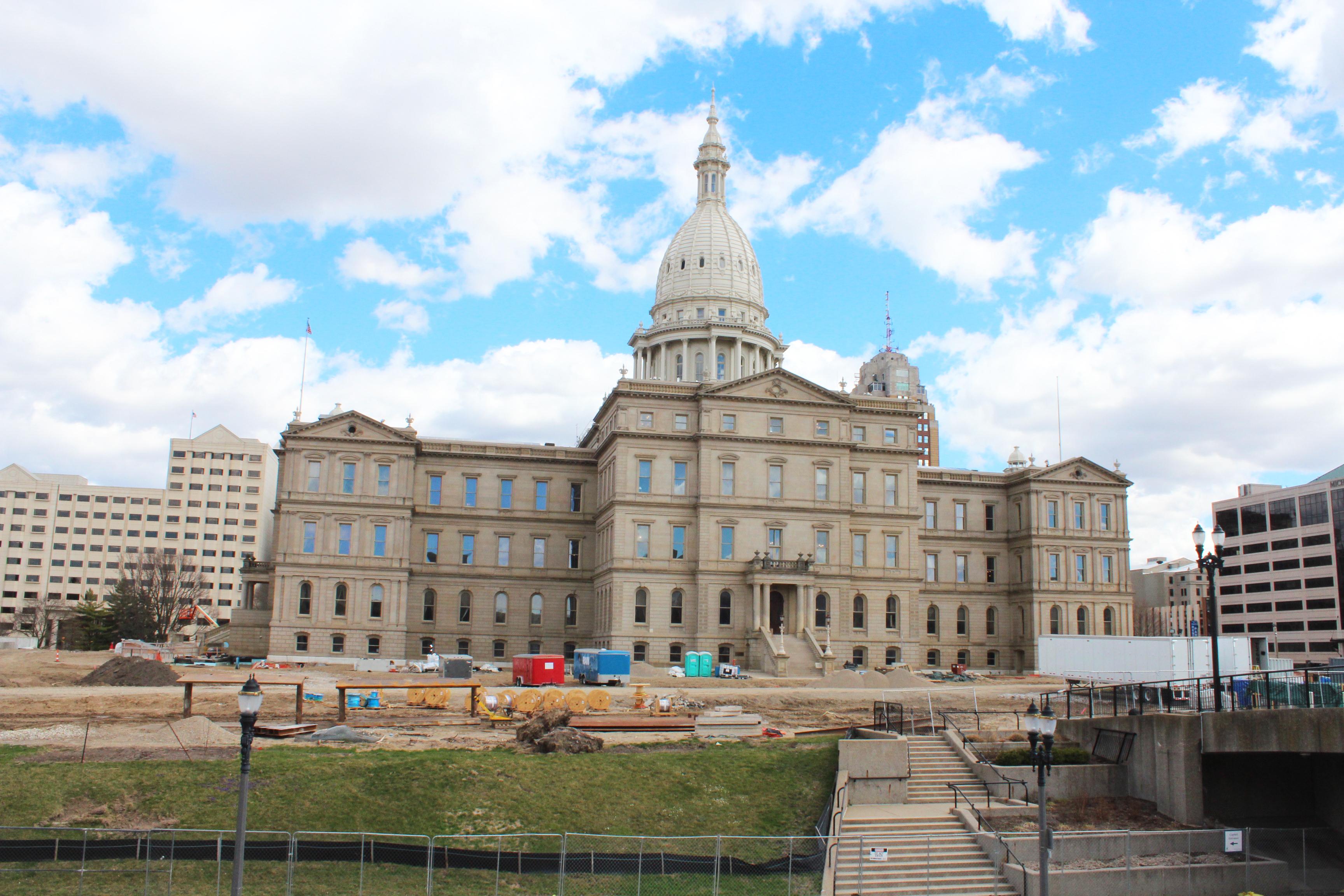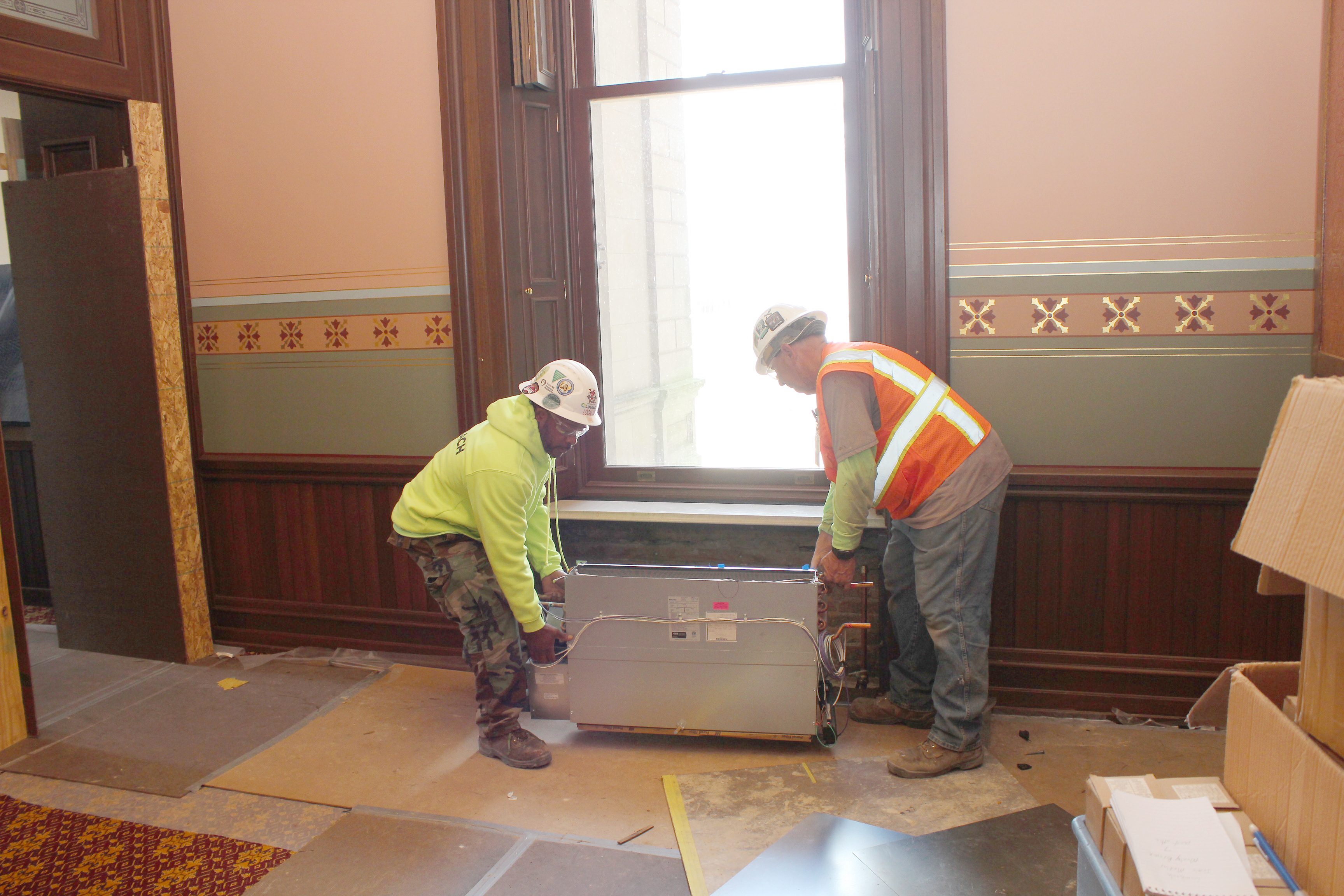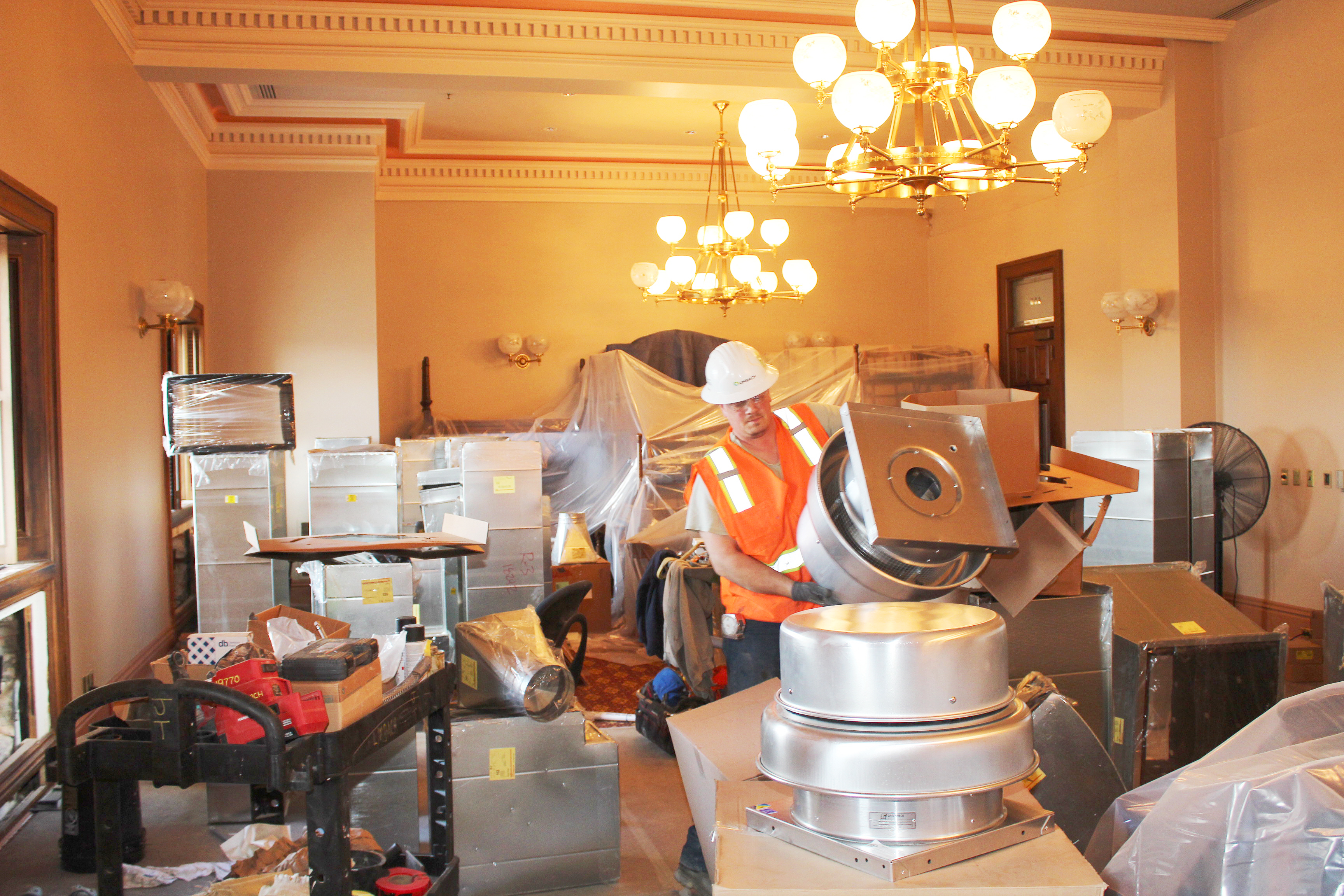Capitol renovation addresses building's needs for now and later
Date Posted: May 3 2019
LANSING - Completed in 1879, the Michigan State Capitol Building has held up remarkably well over the years. Generations of lawmakers and staff have worked in the building's offices, and every day they are joined by schoolchildren, tourists, protestors, and lobbyists roaming its halls and chambers.

THE MICHIGAN CAPITOL BUILDING has been a busy place the past two years, with all manner of renovations and mechanical upgrades in the works. Here on the western (back) side of the building, a geothermal field will allow for use of a new highly efficient heating and cooling system.

HEFTING A FAN COIL UNIT into place in a second floor office at the Capitol Building are DeShon Leek and Jim Lee of Plumbers and Pipe Fitters Local 333. They’re employed by Limbach. The pipe trades crew is installing 350 FCUs in the building.

FAN UNITS are sorted in a fourth floor office in the Michigan Capitol Building by John Bauer of Sheet Metal Workers Local 7, employed by Limbach. John said retrofitting their mechanical handiwork into the 140-old-building is a challenge, “since we have the biggest stuff to fit.”
But all that activity, plus the aging process, and a host of maintenance deficiencies, have taken their toll on the building. Enter the ongoing Capitol Restoration/Infrastructure Upgrade project, a $70 million scheme which began in 2017 with the trades coming on site to put their skills to work all the way from the building's attic, to the historic hallways and offices, to the geothermal system sunk into the earth below.
"The most important thing we're doing here is respecting the fabric of the building," said Rob Blackshaw, director of operations for the Michigan State Capitol Commission. "We have 250,000 people per year coming through the building, and throughout there are nine-and-a-half acres of 140-year-old decorative surfaces that we need to preserve. We have a lot to do, and the biggest challenge involves dealing with the things we can't change: for example, we can't drill a hole through a 140-year-old decorative wall in order to put conduit through it."As the project began in 2017, a report by the Michigan State Capitol Commission outlined some of the deficiencies of the building.
"The MSCC began studying the Capitol’s infrastructure problems in early 2016 in response to a growing number of leaks and failures throughout the building and the subbasement. Alarmed, the Commission hired a team of engineers, architects, and systems specialists to analyze the problems, recommend solutions, and create a road map for addressing potentially catastrophic failures before they occur.
"Fixing these problems - which include things like corroded electrical boxes, leaking pipes, heating and cooling units that are simultaneously blowing warm and cold air, and improper wiring - won’t be easy. While some of the equipment is carefully concealed in hidden mechanical rooms, many projects will touch the Capitol’s most important and historic spaces, including the Senate and House Chambers, legislative offices, and even the dome.
"By the end of the project, the Capitol will have an all new heating and cooling system, and the bulk of the building’s mechanical equipment will be relocated to a new underground Central Utility Plant. Leaking sprinkler heads will be fixed, and corroded electrical boxes and wiring will be replaced. When it’s all done, we will rest secure in the knowledge that our beautiful, 138-year-old building - and the people who work in and visit the Capitol every day - are safe from the threat of a major system failure."
Along with project manager The Christman Co. and its subcontractors, building trades workers have a tremendous amount of work to do. Outside, on the west-side grounds of the Capitol Building, a new geothermal field with 224 bore-holes have been drilled as an integral part of the new super-efficient heating and cooling system. The holes in the 90,000-square-foot field were sunk 500 feet and will contain a closed-loop system of high-density polyethylene pipe filled with water/glycol to help chill and warm the building. Utility costs are expected to decrease by nearly 50 percent with a system payback period of seven years.
The pipes will feed into the underground Central Utility Plant on the south side of the grounds. The new plant will centralize the bulk of the mechanical, electrical, and plumbing equipment serving the Capitol Building, much of which will be new and replace a maze of generations of old MEP systems.
The work includes the installation of heat pumps, air handlers and their associated piping and wiring, as well as the placement of some 350 new fan coil units (replacing 30-year-old+ units) for controlling the temperatures of individual offices and other spaces throughout the building.
A new 275-foot-long electrical duct bank has been installed on the Capitol Building's west side, to help organize buried, incoming electrical cables from throughout the site. The new duct bank links together a new electrical substation room in the Central Utility Plant with equipment in the site's west wing sub-basement and a north generator vault.
The fourth floor of the Capitol has been closed for the spring and summer of this year to address a variety of projects. Windows will be replaced with custom, weathertight, historically accurate versions, matching the fenestration in the rest of the building. Air handlers from the 1980s in the cramped fourth floor attic of the west wing are being given modern replacements. On the east side, existing rooftop mechanical units are being replaced with new HVAC heating/cooling units, installed above slightly lowered ceilings in two rooms.
The project also involves north and south stair replacement, extensive masonry work, as well as waterproofing, plaster and decorative paint repair.
The folks who run the building - Capitol Facilities - has been moved into redesigned and expanded transformed offices in the building, leaving behind poorly organized and overcrowded space.
This renovation builds upon an extensive renovation of the Capitol completed in 1992, that saw extensive cosmetic, structural and mechanical fixes to a building in very rough shape. Blackshaw said an important part of this renovation involved the building information modeling for the entire structure, showing in three dimensions the placement of all structure and placement of mechanical systems in front of and behind walls. Wearing a pair of $3,000 goggles allows a foreman to walk into a room and see, virtually, a color-coded layout of what's happening behind the walls - an invaluable tool when placing a duct, pipe or wire. The system uses an overlay of original plans, plus those gleaned from current and prior renovation blueprints. "It tells a really good story," Blackshaw said.
Alongside the improvements to the Capitol Building will be the construction of the new $55 million Heritage Hall, a 54,000-square-foot underground addition. It will be erected on the northwest corner of the state Capitol Building's campus, and will help relieve the human traffic at the building by acting as a gathering point for tours, providing room for meeting space and large event space.
All the effort to upgrade the building and the grounds bring renewed vigor to Michigan's Capitol Building, one of the state's hidden-in-plain sight gems.
Blackshaw said he's excited to come to work, and that's a sentiment shared by tradespeople on the project. "I love it here," said Plumbers and Pipe Fitters Local 333 journeyman DeShon Leek. "It's such a cool building, with lots of historic interest. You just don't see this anywhere else."
Sheet Metal Workers Local 7's John Bauer, a foreman for Limbach, said he enjoys working at the Capitol - "but it's a challenge. It's very difficult with a building this age to make things fit where they can't be seen. And we have the biggest stuff to fit," he added, referring to the extensive new ductwork they're installing.
"I don't know if people realize the grandeur of this place, the treasure they have in their own backyard," Blackshaw said. "I appreciate the fact that the tradespeople bring a preservation mindset to what they're doing, and they appreciate the historic environment they're working in. It's been a really good job, and what we're seeing is a tribute to their pride and passion. You can tell they want to be here - and that's always a good sign."

THE MICHIGAN CAPITOL BUILDING has been a busy place the past two years, with all manner of renovations and mechanical upgrades in the works. Here on the western (back) side of the building, a geothermal field will allow for use of a new highly efficient heating and cooling system.

HEFTING A FAN COIL UNIT into place in a second floor office at the Capitol Building are DeShon Leek and Jim Lee of Plumbers and Pipe Fitters Local 333. They’re employed by Limbach. The pipe trades crew is installing 350 FCUs in the building.

FAN UNITS are sorted in a fourth floor office in the Michigan Capitol Building by John Bauer of Sheet Metal Workers Local 7, employed by Limbach. John said retrofitting their mechanical handiwork into the 140-old-building is a challenge, “since we have the biggest stuff to fit.”
